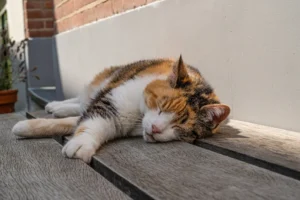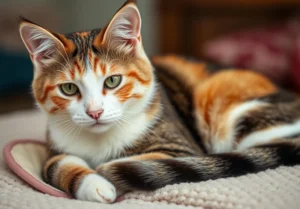Cats’ paws are a source of fascination for many pet owners, but have you ever noticed how cold they can feel at times? In this blog post, we’ll explore the reasons behind why cats’ paws tend to be chilly.
Anatomical Considerations
Have you ever noticed that your feline friend’s paws always seem to be a bit cooler to the touch? Well, there’s a good reason for that! Cats’ paws contain specialized structures called arteriovenous shunts that help regulate their body temperature. These shunts function as tiny valves that direct blood flow away from the skin surface, conserving heat for vital organs like the heart and lungs. As a result, the extremities, such as their adorable little paws, often feel cooler than the rest of their body. So, next time you feel your cat’s cold paws, remember that it’s all thanks to their incredible anatomical design!
Circulation and Thermoregulation
When it comes to understanding why cats’ paws tend to be cooler, we must consider their unique circulation and thermoregulation systems. Cats have a higher body temperature than humans, ranging between 100.5-102.5°F, which means they have to work a bit harder to regulate their heat. One fascinating aspect is that cats can regulate their body temperature by adjusting blood flow to their extremities, such as their paws. By reducing blood flow to these areas, cats can conserve heat for essential organs, maintaining their overall core temperature. So, the next time you feel your cat’s chilly paws, appreciate how their incredible circulation and thermoregulation mechanisms are at work!
Extra Tip: Providing your cat with a cozy bed or blanket to snuggle into can help keep their paws warm during chilly weather, adding an extra level of comfort for your feline friend.
Behavior and Environmental Factors
Cats’ paws can feel cold due to a variety of factors related to their behavior and environment. One common reason for cold paws is when cats spend a lot of time lying on cold surfaces, such as tiles or windowsills. Similarly, if your feline friend loves to play outside in chilly weather, their paws can naturally become colder than usual.
Another contributing factor is poor circulation in a cat’s paws, which can be influenced by their hydration levels. Dehydration can lead to decreased blood flow to the extremities, including their paws, causing them to feel cold to the touch. Additionally, if a cat is older or has certain health conditions, they might be more prone to having cooler paws due to circulation issues.
Unique Insight: How you heat your home can also impact your cat’s paw temperature. If you keep your home on the cooler side, your cat’s paws may naturally feel colder. Providing warm, cozy spots for your cat to lounge can help regulate their paw temperature.
Evolutionary Adaptations
The cold paws of cats can be traced back to their evolutionary adaptations that have helped them survive in the wild. One reason for their cold paws is related to thermoregulation. Cats have a higher body temperature than humans, around 101 to 102.5 degrees Fahrenheit, and their paws are one way they release excess heat to maintain their optimal body temperature.
Furthermore, cats’ wild ancestors, like the African wildcat, needed to preserve their energy and stay stealthy when hunting. Having slightly cooler paws allowed them to sneak up on prey without making noise, as warm paws would have made them more easily detectable. This evolutionary trait has been passed down to our domestic feline friends, explaining why their paws may feel colder than other parts of their bodies.
In essence, when you feel your cat’s cold paws, it’s a reminder of their fascinating evolutionary history and their remarkable adaptations for survival in the wild.
Tips for Keeping Cats’ Paws Warm
If you’ve ever wondered why are cats’ paws cold, fret not, you’re not alone in this question! Cats’ paws tend to be colder than other parts of their bodies due to their unique circulatory system. To keep your feline friend cozy and comfortable, here are some tips to help warm up their paws:
Provide Warm Bedding: Ensure your cat has a soft, warm bed to rest in, especially during colder months. Place it in a cozy corner away from drafts to keep their paws toasty.
Warm Blankets: Place a warm blanket or cushion near a sunny spot in your home where your cat loves to lounge. This can help them warm up their paws naturally.
Massage Their Paws: Gently massage your cat’s paws to stimulate blood flow and improve circulation, helping to warm them up.
Keep Their Environment Warm: Make sure your home is comfortably warm for your cat, especially during colder weather. Consider using a heating pad or heated cat bed to provide extra warmth.
Regular Vet Check-ups: Visit your vet regularly to ensure your cat’s overall health is in check. Cold paws can sometimes indicate an underlying health issue, so it’s essential to address any concerns promptly.
By following these tips, you can help keep your cat’s paws warm and ensure they’re happy and content.
Interesting Facts About Cats’ Paws
Are you curious about some fascinating facts regarding cats’ paws? These amazing creatures have some unique characteristics when it comes to their paws that may surprise you:
Paw Pads: Cats’ paw pads are not just cute; they are also functional. They provide cushioning for the bones and joints in their paws, allowing for silent and stealthy movement.
Sweat Glands: Unlike humans, cats do not have sweat glands all over their bodies. Instead, they rely on their paw pads to release sweat, which helps cool them down during hot weather.
Sharp Claws: Cats’ retractable claws are a marvel of nature. These claws help them grip and climb efficiently, making them exceptional hunters and agile creatures.
Paw Preferences: Just like humans are left or right-handed, cats can be left or right-pawed. Studies have shown that a majority of cats are right-pawed, but some may prefer their left paw for certain tasks.
Sense of Touch: Cats have an incredible sense of touch in their paws. Their paw pads are highly sensitive and contain specialized receptors that help them navigate their environment with precision.
These fun facts about cats’ paws showcase just how incredible and unique these animals are. So, next time you snuggle up with your feline friend, take a moment to appreciate their remarkable paws and all they can do.
Common Misconceptions
Cats’ paws are often thought to be cold due to poor circulation or a sign of sickness. However, cold paws in cats are completely normal. Cats have a higher body temperature than humans, around 100.5 to 102.5 degrees Fahrenheit, so their extremities, like their paws, may feel cooler to the touch. This is just a natural part of their physiology and does not necessarily indicate any health issues.
The Relationship Between Paws and Emotions
Have you ever noticed your cat’s paws feeling colder than usual after a stressful situation? Cats’ paws can actually change temperature based on their emotional state. When feeling anxious or scared, cats may experience vasoconstriction, which causes their paws to feel cooler. On the other hand, when they are relaxed and happy, their paws may feel warmer.
Additionally, pay attention to your cat’s paw temperature as it can be a subtle indicator of their overall well-being. If your cat’s paws consistently feel excessively cold or if they show other symptoms of illness, it’s best to consult with a veterinarian to rule out any potential health issues. Enjoy the warmth and comfort of your feline friend’s paws as they express their emotions through this unique aspect of their physiology.
The Therapeutic Benefits of Warmth
Cats sure do love to cozy up and nap in warm spots, don’t they? Well, that’s not just because they like the feeling of warmth – it actually does wonders for their health. You see, warmth can help improve blood circulation in their paws, which in turn promotes relaxation and reduces stress. Not to mention, warm paws can aid in soothing any aches and pains your furry companion might have. So, next time you see your cat basking in the sun or snuggled up in a warm blanket, know that it’s not just about comfort; it’s about keeping them in tip-top shape.
Unique Ways to Bond with Your Cat Through Their Paws
When it comes to strengthening your bond with your feline friend, focusing on their paws can be a unique and rewarding experience. One fun way to connect with your cat through their paws is by incorporating a gentle paw massage into your daily routine. By softly rubbing their paws, you can create a soothing and relaxing experience for both you and your kitty. Another idea is to incorporate playtime that involves their paws, such as using toys that encourage them to bat and paw at objects. These interactions not only strengthen your bond but also provide mental stimulation for your cat.
Ways to Bond with Your Cat Through Their Paws:
- Paw Massages: Gently massage your cat’s paws to create a calming and bonding experience.
- Interactive Play: Use toys that engage your cat’s paws, like feather wands or string toys.
- Paw-Focused Treat Time: Reward your cat with treats that require them to use their paws to eat, promoting interaction and bonding.
Remember, every interaction you have with your cat, no matter how small, can contribute to a deeper connection and a happier, healthier relationship between you and your furry friend.
Paw Care Essentials
If you’ve ever wondered why your furry friend’s paws feel cold to the touch, don’t worry, it’s completely normal! Cats have a higher body temperature than humans, so their paws tend to feel colder. However, it’s essential to keep an eye on their paw health to ensure they remain comfortable and happy. Here are some paw care essentials for pet owners:
- Regular Inspections: Take a few moments to inspect your cat’s paws regularly for any signs of redness, swelling, cuts, or debris stuck between the toes.
- Keep Paws Clean: Wipe your cat’s paws with a damp cloth after they’ve been outside to remove any dirt or potential irritants.
- Trim Nails: Maintain your cat’s nail length to prevent any discomfort or ingrown nails that could affect their paw health.
- Provide a Soft Bed: Make sure your cat has a soft, comfortable bed to rest their paws on, especially if they spend a lot of time on hard surfaces.
By incorporating these simple paw care tips into your routine, you can help ensure your cat’s paws remain healthy and comfortable.
The Role of Veterinary Care
While it’s common for cats to have cold paws, there are instances where seeking veterinary care may be necessary. If you notice persistent coldness in your cat’s paws accompanied by other symptoms such as limping, licking excessively, or changes in behavior, it’s crucial to consult with a veterinarian. Cold paws could be a sign of underlying issues such as:
- Poor Circulation: Certain medical conditions can affect blood flow to the extremities, leading to cold paws.
- Infections: Fungal infections or injuries can cause discomfort and coldness in the paws.
- Autoimmune Disorders: Conditions like lupus can present with symptoms affecting the paws.
Remember, your cat’s well-being is a top priority, so never hesitate to seek professional care if you have concerns about their paw health. Your veterinarian can provide the best guidance and treatment options tailored to your furry friend’s needs.
Alex, a passionate animal lover, has experience in training and understanding animal behavior. As a proud pet parent to two dogs and three cats, he founded AnimalReport.net to share insights from animal experts and expand his knowledge of the animal kingdom.




